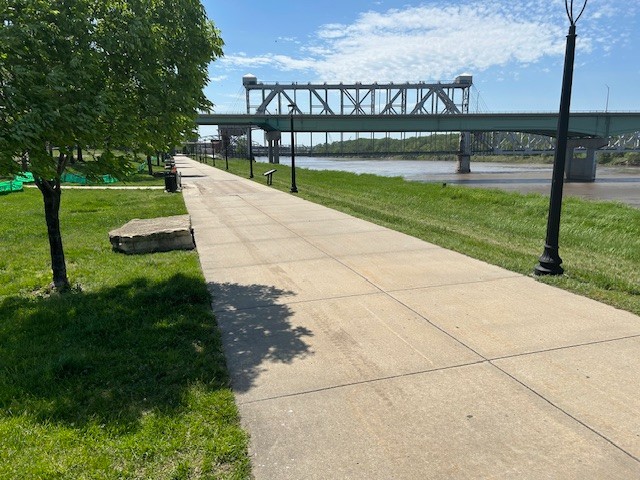Riverfront Heritage Trail
Introduction
Author-Uploaded Audio
Listen to a narration of this entry's description by JCHS.
Text-to-speech Audio
Spanning the Missouri River with a rail line was the problem, and Leavenworth, Kansas 35 miles upriver of Kansas City were the city booster’s biggest competitor for these rights. In 1866 through slick maneuvering by Kearney with eastern railroad investors, and even slighter of hand by Van Horn in Congress to secure federal authorization, Kansas City would outdo Leavenworth. Now all the city leadership had to do was secure the design and capital required to span the river that many predicted could not be crossed.
They persisted and construction of the Hannibal Bridge started in 1867 and its quarter mile span was completed in 1869. The bridge, the only one crossing the Missouri until 1870, was designed by the French engineer Octave Chanute who would also go on to design the Kansas City Stockyards and later become a pioneer in aviation. Considered at the time state of the art engineering, the rail and pedestrian bridge was a swing configuration that could open in under two minutes to allow steamboat traffic to pass. Construction cost $1 million (equivalent to $21.8 million in today’s dollars). Severely damaged in a tornado in 1886, a second Hannibal was built near the first. Despite the construction of many other bridges across the Missouri, the lower deck of the second Hannibal Bridge is still used today for railroad traffic and is the first bridge visible downstream from the site of the Riverfront Streetcar Station.
At the bridge's opening booster Kersey Coates bragged,
“One day Kansas City is going to home of the most important industrial and shipping centers in the nation …. because that is what we are going to make her.”
Images
The Hannibal Bridge, as seen from the Riverfront Heritage Trail

Backstory and Context
Author-Uploaded Audio
Listen to a narration of this entry's description by JCHS.
Text-to-speech Audio
These words as elements of truth as the effect of the bridge on the town was immediate and dramatic in both growth and capital investment. In the first year of the bridge’s opening a quarter-million travelers passed through the town, including 70,000 by train. A population of 4,000 in 1865 grew to 32,000 within five years. A Main Street lot worth $400 in 1856 sold for $11,000 in 1871. The soon newly constructed Union Depot became one of the busiest train stations in the nation, and boxcar after boxcar loaded with cattle pulled into the meat packing plants in the West Bottoms.
Nevertheless, wealth made the town bawdier and even more riotous. The city directory listed 80 saloons and half as many brothels. To writer Charles Gleed, Kansas City at the time,
“Was a sight to make granite eyes shed tears. The population of the city included as fine a collection of ruffian brotherhood and sisterhood of the wild West that could well be imagined. Renegade Indians, demoralized soldiers, unrepentant bushwhackers, and border ruffians, thieves, and thugs imports from everywhere, professional train robbers of home growth and all kinds of human wreckage from the Civil War.”
Their hands full city leaders immediately began turning their attention to the infrastructure needed for a modern metropolis including new laws, fire, police, transportation, boulevards, parks, and roads. No single one of their numerous city road projects was more dramatic than the one that began right where you are standing.
For decades, the area by the original Westport Landing was known by the locals as Gully Town. For millennia, the river had built up a mound of silt in places along this three mile stretch of river that could be as high as an eight-story building. Rocks, trees, and vines crisscrossed through narrow gullies that had been carved out to access the old steamboat landing site and its nearby market stalls. These narrow passages, which became impassable after rains and with houses precariously perched on their edges, had to be dug out by hand to get to the more level ground of the growing city proper to the south beyond.. Said city leader Colonel Theodore S. Case,
“As late as 1870 the site of our town was ridiculous. It was a standing news story that several individuals had been killed by falling off the bluffs in the main part of town onto the roofs of four-story buildings below.”
Largely with the labor of Irish and German immigrants’ tons upon tons of soil and rock were removed with shovels and pick. By hand and mule, the earth was pushed south and graded smooth to make today’s city streets of Grand, Main, Delaware, Wyandotte and Broadway; the area immediately south of the Riverfront Streetcar Station.
In 1980 local historian Carrie Westlake Whitney who witnessed these changes wrote,
“But the old Kansas City has almost vanished and it is essential to have a sense of Kansas City as it was in order to help the older inhabitants to recall the changes and to make the present and future generations appreciate what immense labor was required and what great energy was necessary to develop the topography of the town.”
The Jackson County Historical Society hopes you have enjoyed this brief audio history. Please continue along the streetcar line with us as this tour continues this fascinating story along major districts of Kansas City including the River Market, downtown’s Library District, Union Station, Union Cemetery and Westport. For more information about the Jackson County Historical Society, visit jchs.org.
Sources
Little, Leigh Ann. Olinskey, John M.. Images of America: Early Kansas City, Missouri. Arcadia Publishing, 2013.
Jackson, David W. Kansas City Chronicles: An Up-to-Date History. The History Press, 2010.
Kansas City Missouri: Its History and its People 1808 - 1908. Volume 1. S.J. Clarke Publishing, 1908.
Mathews, Bruse. Noll, Steve. Mackle, Lynn, editor. Kansas City: Our Collective Memories. DGHFKC Books, LLC, 2016.
Foote, Shelby. The Civil War Fredericksburg to Meridian,. Edition Vintage Book Edition. 1963.
